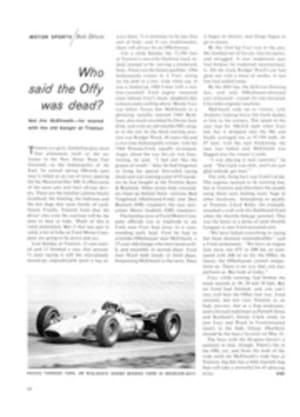
Some bright, icy birds challenge clay pigeons
In the years since the clay pigeon first took to the air in the 1860s, trap and skeet shooting have become so popular in the U.S. that in 1964 more than 100,000 shotgunners plunked down $50 million to bang away at 300 million targets. Yet, oddly, the very growth of these shotgun games has been inhibited by the high cost and the unreliability of clay targets. Now, thanks to three inventors from Buffalo, targets made of ice and colored with glistening fluorescent dyes (opposite) may have a profound effect on the clay-target market and revolutionize shotgun shooting.
These unique ice pigeons meet all of the clay-target specifications for size, shape and flight characteristics. Furthermore, they not only break as easily as clays when hit by a load of shot but they shatter in a burst of brilliant color in sunlight or under floodlights at night, and their tracerlike trajectories make ice pigeons easier for shooters to pick up and follow. More important, ice pigeons help to bring down the high cost of target shooting. Explains co-inventor John C. Kaluzny, a former New York state skeet champion and a process engineer: "Neither the American Trap Association nor the National Skeet Shooting Association specifies that targets be made of clay. And who needs it? Clay is expensive and as fragile as glass. The slightest crack or chip renders a clay target useless, and whole cases of clays are frequently damaged in shipping or handling before they ever reach the trap or skeet house. All these problems and many others would be eliminated by manufacturing ice targets quickly and economically with refrigeration units installed right in trap and skeet houses."
Kaluzny and his partners—David Meyer, a mechanical engineer who did most of the designing, and Richard E. McPherson, a government contract administrator—spent almost three years developing the idea. Their ice-target-making machine will turn out perfect ice pigeons as fast as any trap or skeet squad could want them. By the inventors' conservative estimate, shooting clubs that install ice machines could offer shotgunners four rounds of ice pigeons for the same price as they now pay for one round of clays.
Ice pigeons have other inherent advantages. No longer will trap or skeet fields be littered with piles of clay-target debris. With the first breath of warm air, ice-pigeon fragments melt and soak into the ground. Chemically inert dyes preclude any danger to vegetation, birds or animals. Clubs need not invest a sizable chunk of money in clay-target inventory. Says Dick McPherson: "The whole idea is really rather simple. Flexible molds on a conveyer belt are filled with precisely metered amounts of water and dye and passed through freezing chambers. The frozen targets are then released from the molds and fed directly from the machine onto the throwing arm of the trap, one at a time."
The machine produces only uniform targets. "The secret," says McPherson, "is in the molds, which allow frozen targets to pop out undamaged." No longer will shooters be unnerved by damaged clays that disintegrate when ejected from the trap. And on hot days a melting target automatically will be dropped from the throwing arm and immediately replaced with a new one.
Water is supplied to the target-making machine through reservoir tanks or a permanent system of pipes. A few gallons go a long way. "There are about four liquid ounces to a target," says McPherson, "and at least 32 targets to the gallon. We may eventually be able to increase that figure." Color dyes can be altered to suit the lighting conditions and backgrounds. With only a few minor adjustments any automatic trap machine can be converted to throw ice pigeons.
The inventors have patented their machine and have a patent pending on the target. What they do not yet have is a working model. Explains McPherson: "We hope to sell the whole package to a manufacturer in the sporting arms and ammunition industry." McPherson does not expect to make clay targets obsolete overnight. Serious shotgunners competing in registered shoots may be reluctant at first to switch from clay to ice, and for the thousands of occasional shooters who throw clays with inexpensive hand traps, ice pigeons are impracticable. The inventors may even have some competition from the Japanese, who are trying to find an economical method of remolding broken clays into new targets, and from at least one U.S. manufacturer who is working with new materials that could be molded instantaneously into targets in trap and skeet houses.
Even though ice pigeons are not yet available to shooters, McPherson and his partners are already dreaming up ways to improve them. "We hope to make our targets scream by putting indentations or vents into the molds," says John Kaluzny. "It would add more excitement to shooting and make it easier for referees to call dead or lost birds in registered shoots." The inventors may even try to take the bang out of shooting by developing some sort of "silent shotgun" loaded with a secret ingredient that would break ice targets. "The day may come," says Kaluzny, "when it will be possible to shoot trap and skeet at drive-in ranges right in the middle of town without disturbing the neighbors."
PHOTO
RICHARD MEEK

